Innovation and Commercialisation Report for Kennington Lane Cafe
VerifiedAdded on 2023/01/19
|16
|5327
|95
Report
AI Summary
This report delves into the concepts of innovation and commercialization within the context of Kennington Lane Cafe, a London-based eatery. It begins by differentiating between invention and innovation, emphasizing the importance of organizational culture, leadership, teamwork, and vision in fost...
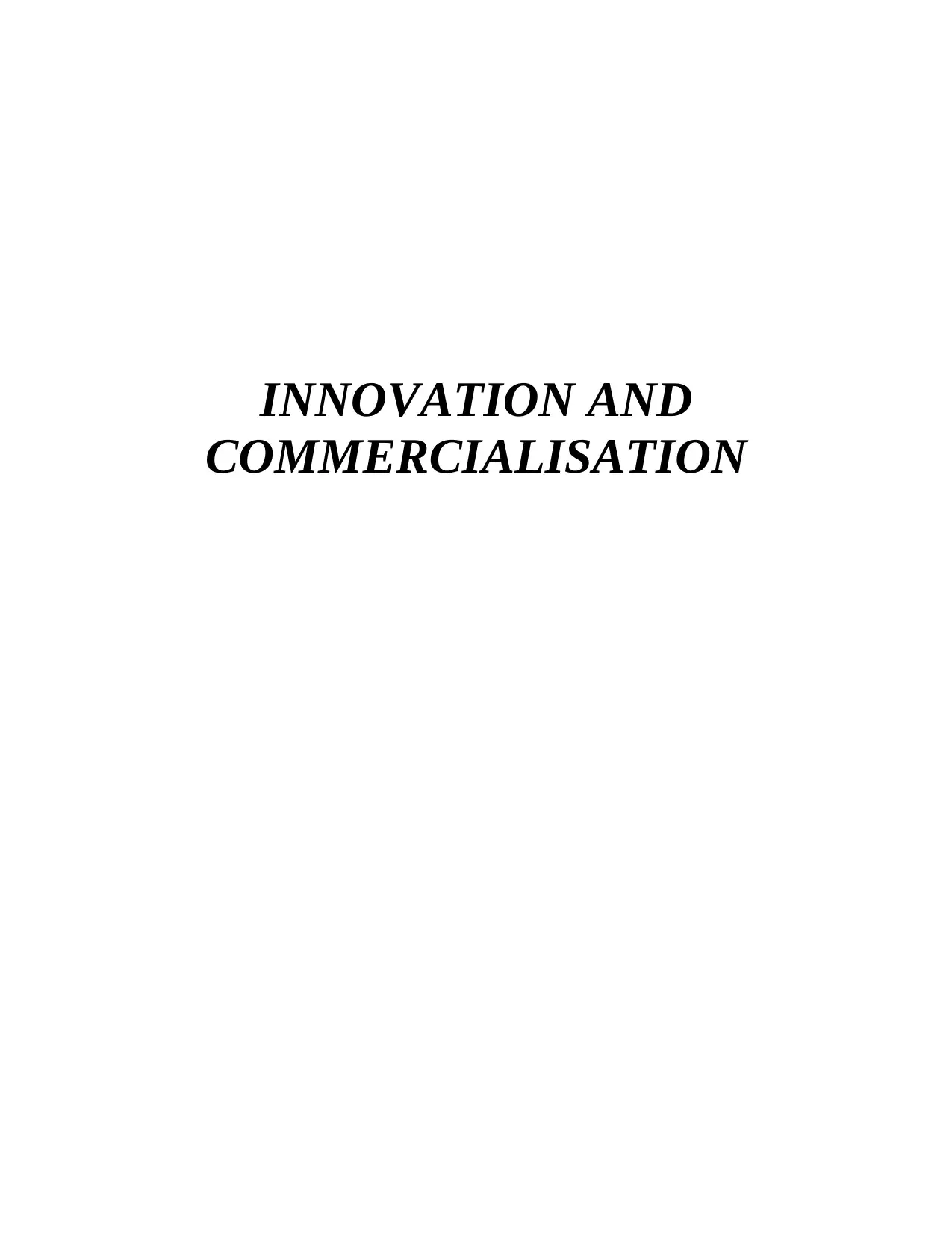
INNOVATION AND
COMMERCIALISATION
COMMERCIALISATION
Secure Best Marks with AI Grader
Need help grading? Try our AI Grader for instant feedback on your assignments.
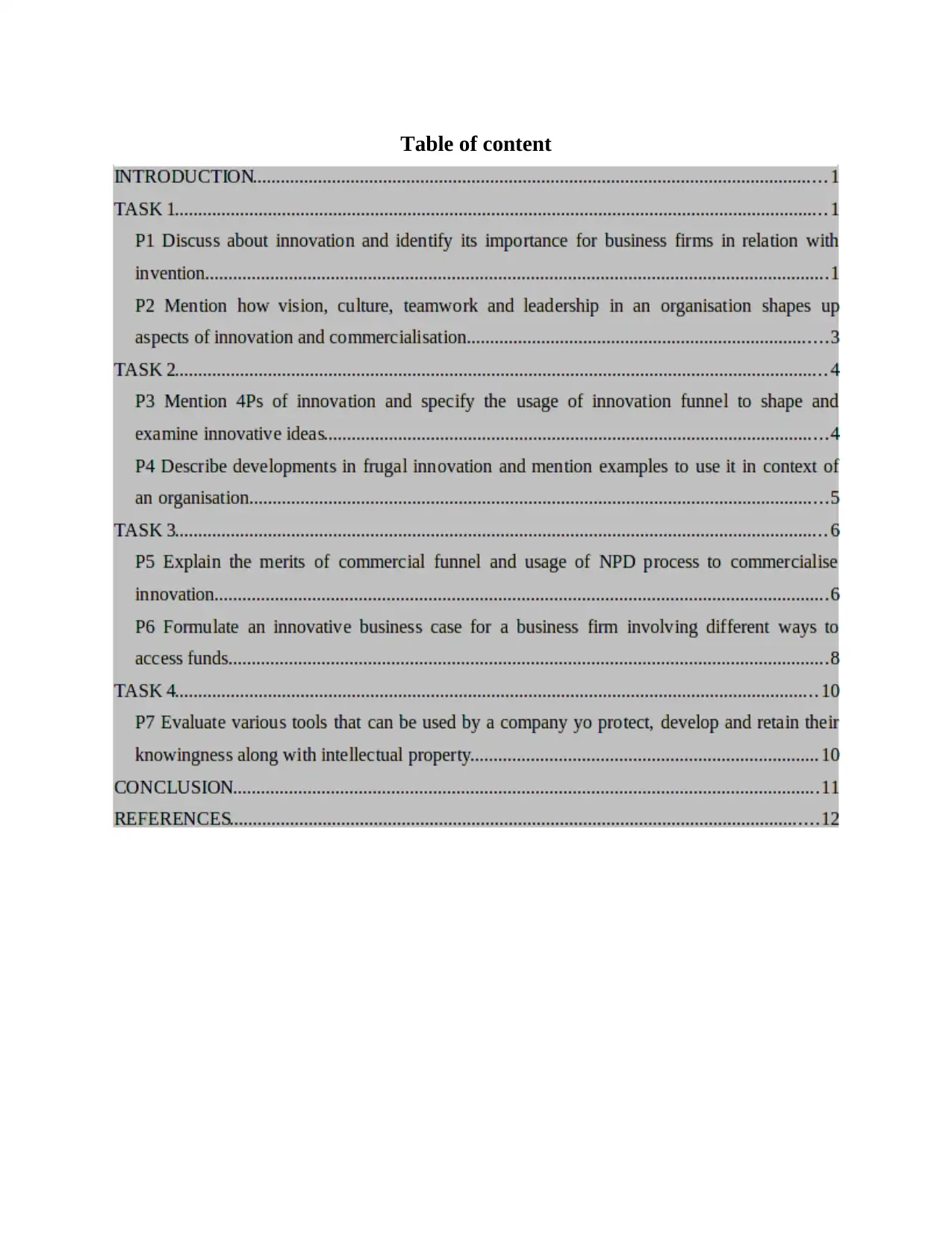
Table of content
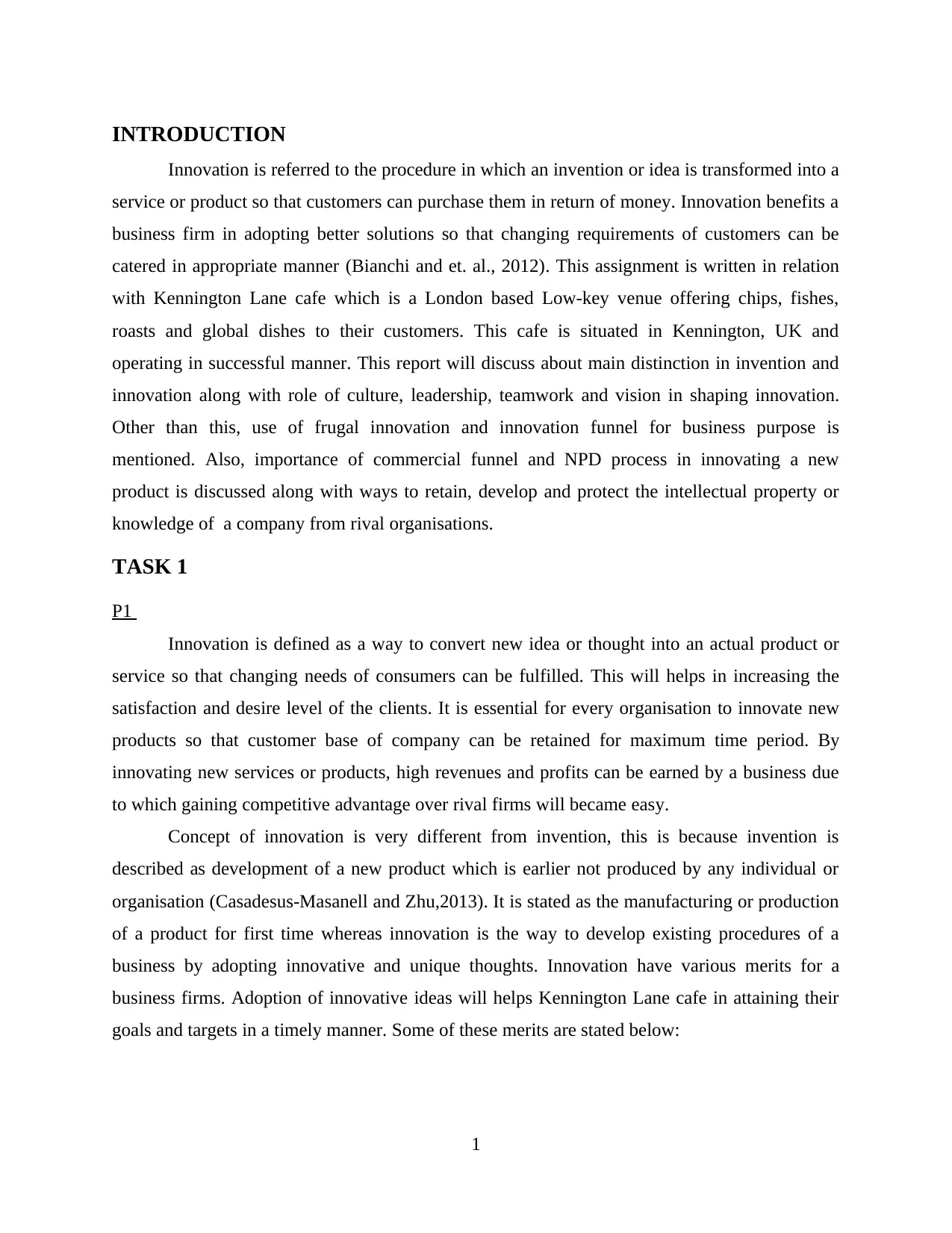
INTRODUCTION
Innovation is referred to the procedure in which an invention or idea is transformed into a
service or product so that customers can purchase them in return of money. Innovation benefits a
business firm in adopting better solutions so that changing requirements of customers can be
catered in appropriate manner (Bianchi and et. al., 2012). This assignment is written in relation
with Kennington Lane cafe which is a London based Low-key venue offering chips, fishes,
roasts and global dishes to their customers. This cafe is situated in Kennington, UK and
operating in successful manner. This report will discuss about main distinction in invention and
innovation along with role of culture, leadership, teamwork and vision in shaping innovation.
Other than this, use of frugal innovation and innovation funnel for business purpose is
mentioned. Also, importance of commercial funnel and NPD process in innovating a new
product is discussed along with ways to retain, develop and protect the intellectual property or
knowledge of a company from rival organisations.
TASK 1
P1
Innovation is defined as a way to convert new idea or thought into an actual product or
service so that changing needs of consumers can be fulfilled. This will helps in increasing the
satisfaction and desire level of the clients. It is essential for every organisation to innovate new
products so that customer base of company can be retained for maximum time period. By
innovating new services or products, high revenues and profits can be earned by a business due
to which gaining competitive advantage over rival firms will became easy.
Concept of innovation is very different from invention, this is because invention is
described as development of a new product which is earlier not produced by any individual or
organisation (Casadesus‐Masanell and Zhu,2013). It is stated as the manufacturing or production
of a product for first time whereas innovation is the way to develop existing procedures of a
business by adopting innovative and unique thoughts. Innovation have various merits for a
business firms. Adoption of innovative ideas will helps Kennington Lane cafe in attaining their
goals and targets in a timely manner. Some of these merits are stated below:
1
Innovation is referred to the procedure in which an invention or idea is transformed into a
service or product so that customers can purchase them in return of money. Innovation benefits a
business firm in adopting better solutions so that changing requirements of customers can be
catered in appropriate manner (Bianchi and et. al., 2012). This assignment is written in relation
with Kennington Lane cafe which is a London based Low-key venue offering chips, fishes,
roasts and global dishes to their customers. This cafe is situated in Kennington, UK and
operating in successful manner. This report will discuss about main distinction in invention and
innovation along with role of culture, leadership, teamwork and vision in shaping innovation.
Other than this, use of frugal innovation and innovation funnel for business purpose is
mentioned. Also, importance of commercial funnel and NPD process in innovating a new
product is discussed along with ways to retain, develop and protect the intellectual property or
knowledge of a company from rival organisations.
TASK 1
P1
Innovation is defined as a way to convert new idea or thought into an actual product or
service so that changing needs of consumers can be fulfilled. This will helps in increasing the
satisfaction and desire level of the clients. It is essential for every organisation to innovate new
products so that customer base of company can be retained for maximum time period. By
innovating new services or products, high revenues and profits can be earned by a business due
to which gaining competitive advantage over rival firms will became easy.
Concept of innovation is very different from invention, this is because invention is
described as development of a new product which is earlier not produced by any individual or
organisation (Casadesus‐Masanell and Zhu,2013). It is stated as the manufacturing or production
of a product for first time whereas innovation is the way to develop existing procedures of a
business by adopting innovative and unique thoughts. Innovation have various merits for a
business firms. Adoption of innovative ideas will helps Kennington Lane cafe in attaining their
goals and targets in a timely manner. Some of these merits are stated below:
1
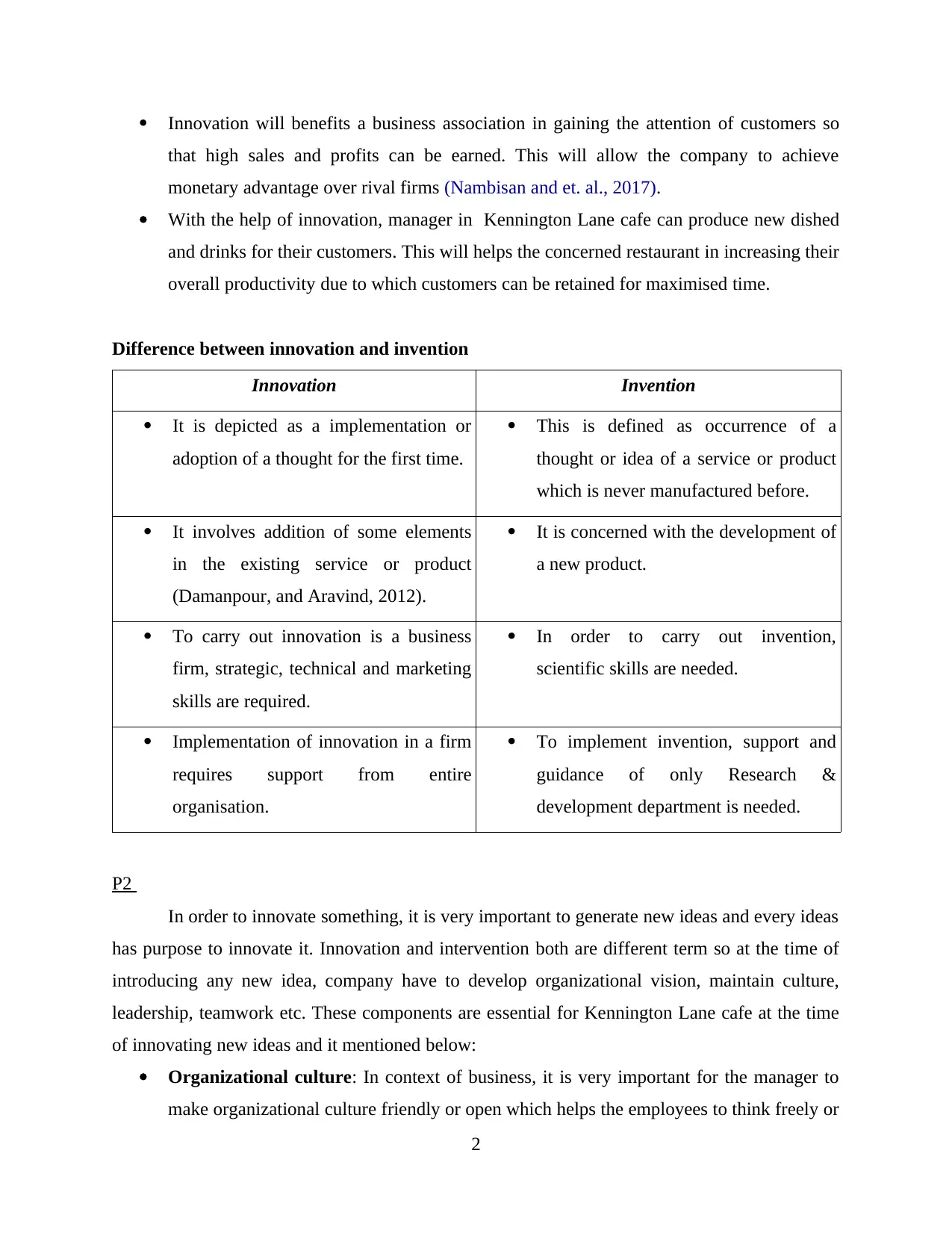
Innovation will benefits a business association in gaining the attention of customers so
that high sales and profits can be earned. This will allow the company to achieve
monetary advantage over rival firms (Nambisan and et. al., 2017).
With the help of innovation, manager in Kennington Lane cafe can produce new dished
and drinks for their customers. This will helps the concerned restaurant in increasing their
overall productivity due to which customers can be retained for maximised time.
Difference between innovation and invention
Innovation Invention
It is depicted as a implementation or
adoption of a thought for the first time.
This is defined as occurrence of a
thought or idea of a service or product
which is never manufactured before.
It involves addition of some elements
in the existing service or product
(Damanpour, and Aravind, 2012).
It is concerned with the development of
a new product.
To carry out innovation is a business
firm, strategic, technical and marketing
skills are required.
In order to carry out invention,
scientific skills are needed.
Implementation of innovation in a firm
requires support from entire
organisation.
To implement invention, support and
guidance of only Research &
development department is needed.
P2
In order to innovate something, it is very important to generate new ideas and every ideas
has purpose to innovate it. Innovation and intervention both are different term so at the time of
introducing any new idea, company have to develop organizational vision, maintain culture,
leadership, teamwork etc. These components are essential for Kennington Lane cafe at the time
of innovating new ideas and it mentioned below:
Organizational culture: In context of business, it is very important for the manager to
make organizational culture friendly or open which helps the employees to think freely or
2
that high sales and profits can be earned. This will allow the company to achieve
monetary advantage over rival firms (Nambisan and et. al., 2017).
With the help of innovation, manager in Kennington Lane cafe can produce new dished
and drinks for their customers. This will helps the concerned restaurant in increasing their
overall productivity due to which customers can be retained for maximised time.
Difference between innovation and invention
Innovation Invention
It is depicted as a implementation or
adoption of a thought for the first time.
This is defined as occurrence of a
thought or idea of a service or product
which is never manufactured before.
It involves addition of some elements
in the existing service or product
(Damanpour, and Aravind, 2012).
It is concerned with the development of
a new product.
To carry out innovation is a business
firm, strategic, technical and marketing
skills are required.
In order to carry out invention,
scientific skills are needed.
Implementation of innovation in a firm
requires support from entire
organisation.
To implement invention, support and
guidance of only Research &
development department is needed.
P2
In order to innovate something, it is very important to generate new ideas and every ideas
has purpose to innovate it. Innovation and intervention both are different term so at the time of
introducing any new idea, company have to develop organizational vision, maintain culture,
leadership, teamwork etc. These components are essential for Kennington Lane cafe at the time
of innovating new ideas and it mentioned below:
Organizational culture: In context of business, it is very important for the manager to
make organizational culture friendly or open which helps the employees to think freely or
2
Secure Best Marks with AI Grader
Need help grading? Try our AI Grader for instant feedback on your assignments.
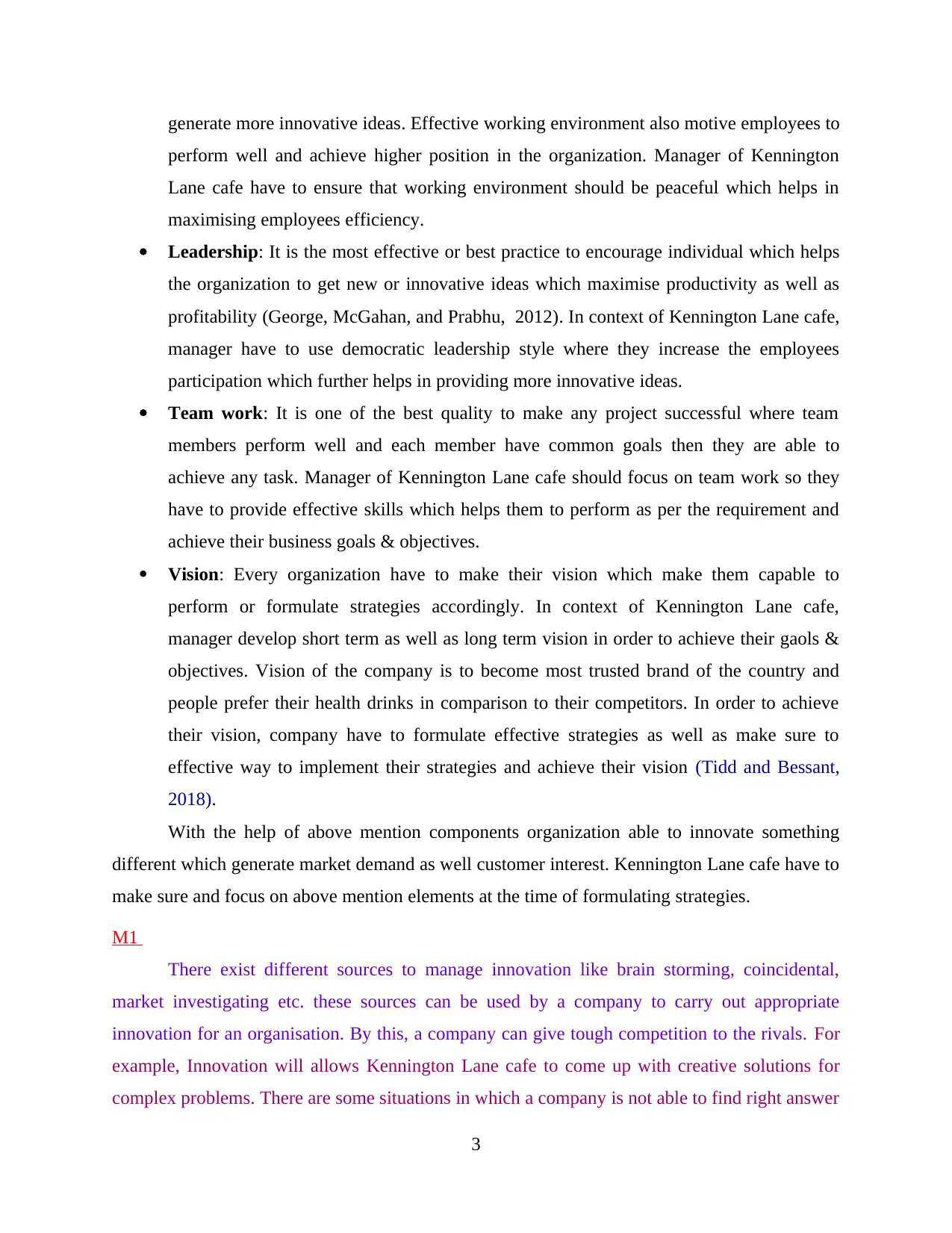
generate more innovative ideas. Effective working environment also motive employees to
perform well and achieve higher position in the organization. Manager of Kennington
Lane cafe have to ensure that working environment should be peaceful which helps in
maximising employees efficiency.
Leadership: It is the most effective or best practice to encourage individual which helps
the organization to get new or innovative ideas which maximise productivity as well as
profitability (George, McGahan, and Prabhu, 2012). In context of Kennington Lane cafe,
manager have to use democratic leadership style where they increase the employees
participation which further helps in providing more innovative ideas.
Team work: It is one of the best quality to make any project successful where team
members perform well and each member have common goals then they are able to
achieve any task. Manager of Kennington Lane cafe should focus on team work so they
have to provide effective skills which helps them to perform as per the requirement and
achieve their business goals & objectives.
Vision: Every organization have to make their vision which make them capable to
perform or formulate strategies accordingly. In context of Kennington Lane cafe,
manager develop short term as well as long term vision in order to achieve their gaols &
objectives. Vision of the company is to become most trusted brand of the country and
people prefer their health drinks in comparison to their competitors. In order to achieve
their vision, company have to formulate effective strategies as well as make sure to
effective way to implement their strategies and achieve their vision (Tidd and Bessant,
2018).
With the help of above mention components organization able to innovate something
different which generate market demand as well customer interest. Kennington Lane cafe have to
make sure and focus on above mention elements at the time of formulating strategies.
M1
There exist different sources to manage innovation like brain storming, coincidental,
market investigating etc. these sources can be used by a company to carry out appropriate
innovation for an organisation. By this, a company can give tough competition to the rivals. For
example, Innovation will allows Kennington Lane cafe to come up with creative solutions for
complex problems. There are some situations in which a company is not able to find right answer
3
perform well and achieve higher position in the organization. Manager of Kennington
Lane cafe have to ensure that working environment should be peaceful which helps in
maximising employees efficiency.
Leadership: It is the most effective or best practice to encourage individual which helps
the organization to get new or innovative ideas which maximise productivity as well as
profitability (George, McGahan, and Prabhu, 2012). In context of Kennington Lane cafe,
manager have to use democratic leadership style where they increase the employees
participation which further helps in providing more innovative ideas.
Team work: It is one of the best quality to make any project successful where team
members perform well and each member have common goals then they are able to
achieve any task. Manager of Kennington Lane cafe should focus on team work so they
have to provide effective skills which helps them to perform as per the requirement and
achieve their business goals & objectives.
Vision: Every organization have to make their vision which make them capable to
perform or formulate strategies accordingly. In context of Kennington Lane cafe,
manager develop short term as well as long term vision in order to achieve their gaols &
objectives. Vision of the company is to become most trusted brand of the country and
people prefer their health drinks in comparison to their competitors. In order to achieve
their vision, company have to formulate effective strategies as well as make sure to
effective way to implement their strategies and achieve their vision (Tidd and Bessant,
2018).
With the help of above mention components organization able to innovate something
different which generate market demand as well customer interest. Kennington Lane cafe have to
make sure and focus on above mention elements at the time of formulating strategies.
M1
There exist different sources to manage innovation like brain storming, coincidental,
market investigating etc. these sources can be used by a company to carry out appropriate
innovation for an organisation. By this, a company can give tough competition to the rivals. For
example, Innovation will allows Kennington Lane cafe to come up with creative solutions for
complex problems. There are some situations in which a company is not able to find right answer
3
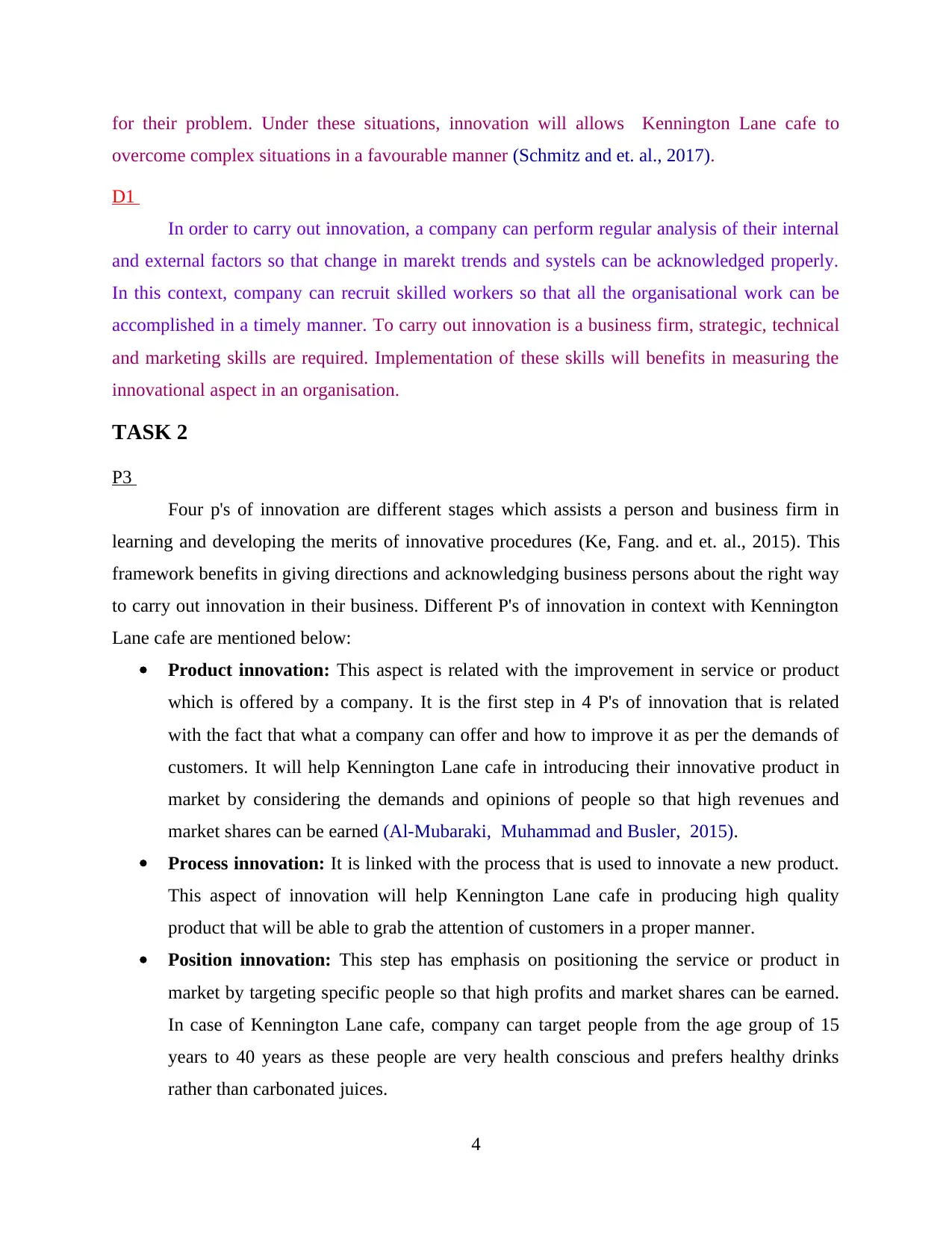
for their problem. Under these situations, innovation will allows Kennington Lane cafe to
overcome complex situations in a favourable manner (Schmitz and et. al., 2017).
D1
In order to carry out innovation, a company can perform regular analysis of their internal
and external factors so that change in marekt trends and systels can be acknowledged properly.
In this context, company can recruit skilled workers so that all the organisational work can be
accomplished in a timely manner. To carry out innovation is a business firm, strategic, technical
and marketing skills are required. Implementation of these skills will benefits in measuring the
innovational aspect in an organisation.
TASK 2
P3
Four p's of innovation are different stages which assists a person and business firm in
learning and developing the merits of innovative procedures (Ke, Fang. and et. al., 2015). This
framework benefits in giving directions and acknowledging business persons about the right way
to carry out innovation in their business. Different P's of innovation in context with Kennington
Lane cafe are mentioned below:
Product innovation: This aspect is related with the improvement in service or product
which is offered by a company. It is the first step in 4 P's of innovation that is related
with the fact that what a company can offer and how to improve it as per the demands of
customers. It will help Kennington Lane cafe in introducing their innovative product in
market by considering the demands and opinions of people so that high revenues and
market shares can be earned (Al-Mubaraki, Muhammad and Busler, 2015).
Process innovation: It is linked with the process that is used to innovate a new product.
This aspect of innovation will help Kennington Lane cafe in producing high quality
product that will be able to grab the attention of customers in a proper manner.
Position innovation: This step has emphasis on positioning the service or product in
market by targeting specific people so that high profits and market shares can be earned.
In case of Kennington Lane cafe, company can target people from the age group of 15
years to 40 years as these people are very health conscious and prefers healthy drinks
rather than carbonated juices.
4
overcome complex situations in a favourable manner (Schmitz and et. al., 2017).
D1
In order to carry out innovation, a company can perform regular analysis of their internal
and external factors so that change in marekt trends and systels can be acknowledged properly.
In this context, company can recruit skilled workers so that all the organisational work can be
accomplished in a timely manner. To carry out innovation is a business firm, strategic, technical
and marketing skills are required. Implementation of these skills will benefits in measuring the
innovational aspect in an organisation.
TASK 2
P3
Four p's of innovation are different stages which assists a person and business firm in
learning and developing the merits of innovative procedures (Ke, Fang. and et. al., 2015). This
framework benefits in giving directions and acknowledging business persons about the right way
to carry out innovation in their business. Different P's of innovation in context with Kennington
Lane cafe are mentioned below:
Product innovation: This aspect is related with the improvement in service or product
which is offered by a company. It is the first step in 4 P's of innovation that is related
with the fact that what a company can offer and how to improve it as per the demands of
customers. It will help Kennington Lane cafe in introducing their innovative product in
market by considering the demands and opinions of people so that high revenues and
market shares can be earned (Al-Mubaraki, Muhammad and Busler, 2015).
Process innovation: It is linked with the process that is used to innovate a new product.
This aspect of innovation will help Kennington Lane cafe in producing high quality
product that will be able to grab the attention of customers in a proper manner.
Position innovation: This step has emphasis on positioning the service or product in
market by targeting specific people so that high profits and market shares can be earned.
In case of Kennington Lane cafe, company can target people from the age group of 15
years to 40 years as these people are very health conscious and prefers healthy drinks
rather than carbonated juices.
4
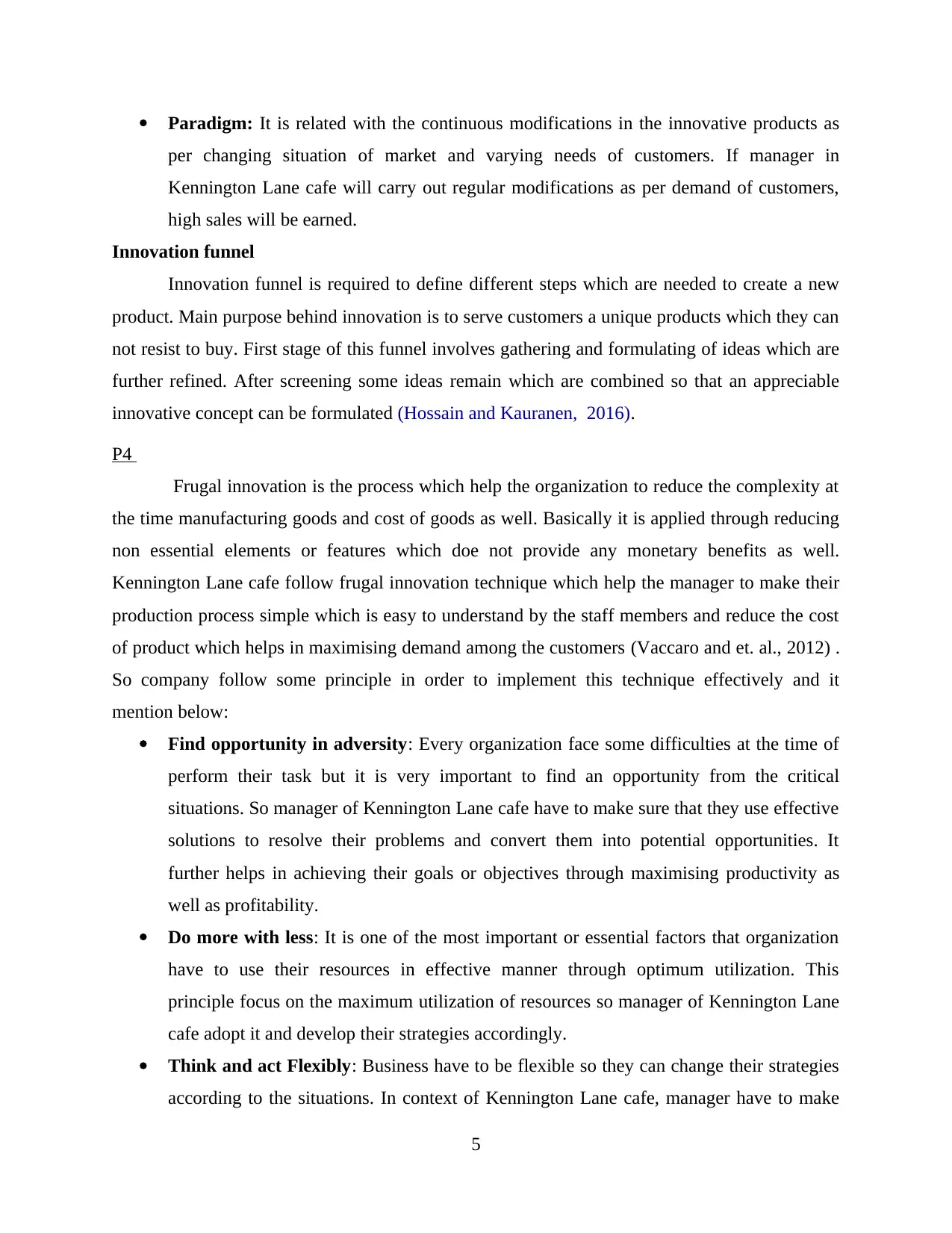
Paradigm: It is related with the continuous modifications in the innovative products as
per changing situation of market and varying needs of customers. If manager in
Kennington Lane cafe will carry out regular modifications as per demand of customers,
high sales will be earned.
Innovation funnel
Innovation funnel is required to define different steps which are needed to create a new
product. Main purpose behind innovation is to serve customers a unique products which they can
not resist to buy. First stage of this funnel involves gathering and formulating of ideas which are
further refined. After screening some ideas remain which are combined so that an appreciable
innovative concept can be formulated (Hossain and Kauranen, 2016).
P4
Frugal innovation is the process which help the organization to reduce the complexity at
the time manufacturing goods and cost of goods as well. Basically it is applied through reducing
non essential elements or features which doe not provide any monetary benefits as well.
Kennington Lane cafe follow frugal innovation technique which help the manager to make their
production process simple which is easy to understand by the staff members and reduce the cost
of product which helps in maximising demand among the customers (Vaccaro and et. al., 2012) .
So company follow some principle in order to implement this technique effectively and it
mention below:
Find opportunity in adversity: Every organization face some difficulties at the time of
perform their task but it is very important to find an opportunity from the critical
situations. So manager of Kennington Lane cafe have to make sure that they use effective
solutions to resolve their problems and convert them into potential opportunities. It
further helps in achieving their goals or objectives through maximising productivity as
well as profitability.
Do more with less: It is one of the most important or essential factors that organization
have to use their resources in effective manner through optimum utilization. This
principle focus on the maximum utilization of resources so manager of Kennington Lane
cafe adopt it and develop their strategies accordingly.
Think and act Flexibly: Business have to be flexible so they can change their strategies
according to the situations. In context of Kennington Lane cafe, manager have to make
5
per changing situation of market and varying needs of customers. If manager in
Kennington Lane cafe will carry out regular modifications as per demand of customers,
high sales will be earned.
Innovation funnel
Innovation funnel is required to define different steps which are needed to create a new
product. Main purpose behind innovation is to serve customers a unique products which they can
not resist to buy. First stage of this funnel involves gathering and formulating of ideas which are
further refined. After screening some ideas remain which are combined so that an appreciable
innovative concept can be formulated (Hossain and Kauranen, 2016).
P4
Frugal innovation is the process which help the organization to reduce the complexity at
the time manufacturing goods and cost of goods as well. Basically it is applied through reducing
non essential elements or features which doe not provide any monetary benefits as well.
Kennington Lane cafe follow frugal innovation technique which help the manager to make their
production process simple which is easy to understand by the staff members and reduce the cost
of product which helps in maximising demand among the customers (Vaccaro and et. al., 2012) .
So company follow some principle in order to implement this technique effectively and it
mention below:
Find opportunity in adversity: Every organization face some difficulties at the time of
perform their task but it is very important to find an opportunity from the critical
situations. So manager of Kennington Lane cafe have to make sure that they use effective
solutions to resolve their problems and convert them into potential opportunities. It
further helps in achieving their goals or objectives through maximising productivity as
well as profitability.
Do more with less: It is one of the most important or essential factors that organization
have to use their resources in effective manner through optimum utilization. This
principle focus on the maximum utilization of resources so manager of Kennington Lane
cafe adopt it and develop their strategies accordingly.
Think and act Flexibly: Business have to be flexible so they can change their strategies
according to the situations. In context of Kennington Lane cafe, manager have to make
5
Paraphrase This Document
Need a fresh take? Get an instant paraphrase of this document with our AI Paraphraser
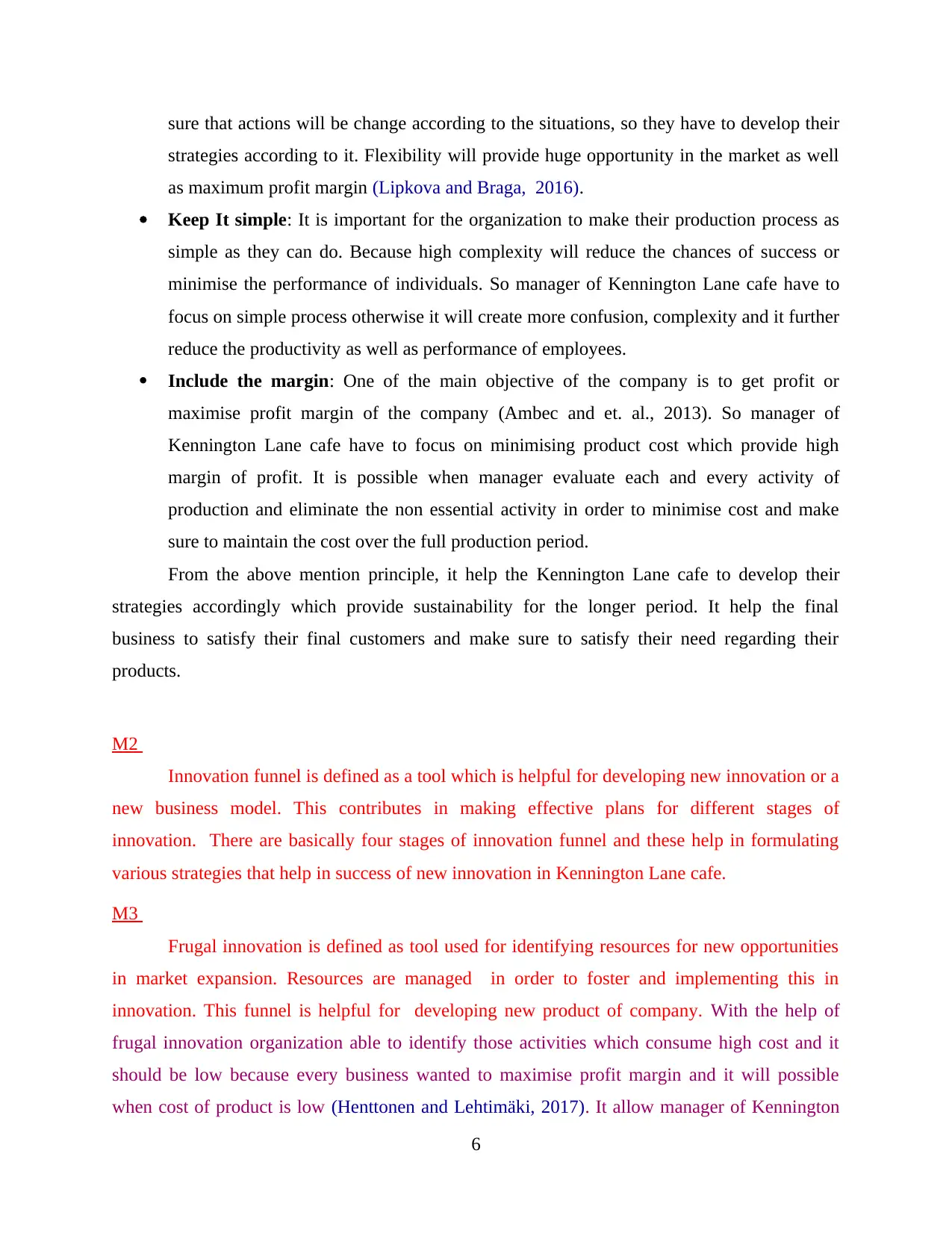
sure that actions will be change according to the situations, so they have to develop their
strategies according to it. Flexibility will provide huge opportunity in the market as well
as maximum profit margin (Lipkova and Braga, 2016).
Keep It simple: It is important for the organization to make their production process as
simple as they can do. Because high complexity will reduce the chances of success or
minimise the performance of individuals. So manager of Kennington Lane cafe have to
focus on simple process otherwise it will create more confusion, complexity and it further
reduce the productivity as well as performance of employees.
Include the margin: One of the main objective of the company is to get profit or
maximise profit margin of the company (Ambec and et. al., 2013). So manager of
Kennington Lane cafe have to focus on minimising product cost which provide high
margin of profit. It is possible when manager evaluate each and every activity of
production and eliminate the non essential activity in order to minimise cost and make
sure to maintain the cost over the full production period.
From the above mention principle, it help the Kennington Lane cafe to develop their
strategies accordingly which provide sustainability for the longer period. It help the final
business to satisfy their final customers and make sure to satisfy their need regarding their
products.
M2
Innovation funnel is defined as a tool which is helpful for developing new innovation or a
new business model. This contributes in making effective plans for different stages of
innovation. There are basically four stages of innovation funnel and these help in formulating
various strategies that help in success of new innovation in Kennington Lane cafe.
M3
Frugal innovation is defined as tool used for identifying resources for new opportunities
in market expansion. Resources are managed in order to foster and implementing this in
innovation. This funnel is helpful for developing new product of company. With the help of
frugal innovation organization able to identify those activities which consume high cost and it
should be low because every business wanted to maximise profit margin and it will possible
when cost of product is low (Henttonen and Lehtimäki, 2017). It allow manager of Kennington
6
strategies according to it. Flexibility will provide huge opportunity in the market as well
as maximum profit margin (Lipkova and Braga, 2016).
Keep It simple: It is important for the organization to make their production process as
simple as they can do. Because high complexity will reduce the chances of success or
minimise the performance of individuals. So manager of Kennington Lane cafe have to
focus on simple process otherwise it will create more confusion, complexity and it further
reduce the productivity as well as performance of employees.
Include the margin: One of the main objective of the company is to get profit or
maximise profit margin of the company (Ambec and et. al., 2013). So manager of
Kennington Lane cafe have to focus on minimising product cost which provide high
margin of profit. It is possible when manager evaluate each and every activity of
production and eliminate the non essential activity in order to minimise cost and make
sure to maintain the cost over the full production period.
From the above mention principle, it help the Kennington Lane cafe to develop their
strategies accordingly which provide sustainability for the longer period. It help the final
business to satisfy their final customers and make sure to satisfy their need regarding their
products.
M2
Innovation funnel is defined as a tool which is helpful for developing new innovation or a
new business model. This contributes in making effective plans for different stages of
innovation. There are basically four stages of innovation funnel and these help in formulating
various strategies that help in success of new innovation in Kennington Lane cafe.
M3
Frugal innovation is defined as tool used for identifying resources for new opportunities
in market expansion. Resources are managed in order to foster and implementing this in
innovation. This funnel is helpful for developing new product of company. With the help of
frugal innovation organization able to identify those activities which consume high cost and it
should be low because every business wanted to maximise profit margin and it will possible
when cost of product is low (Henttonen and Lehtimäki, 2017). It allow manager of Kennington
6
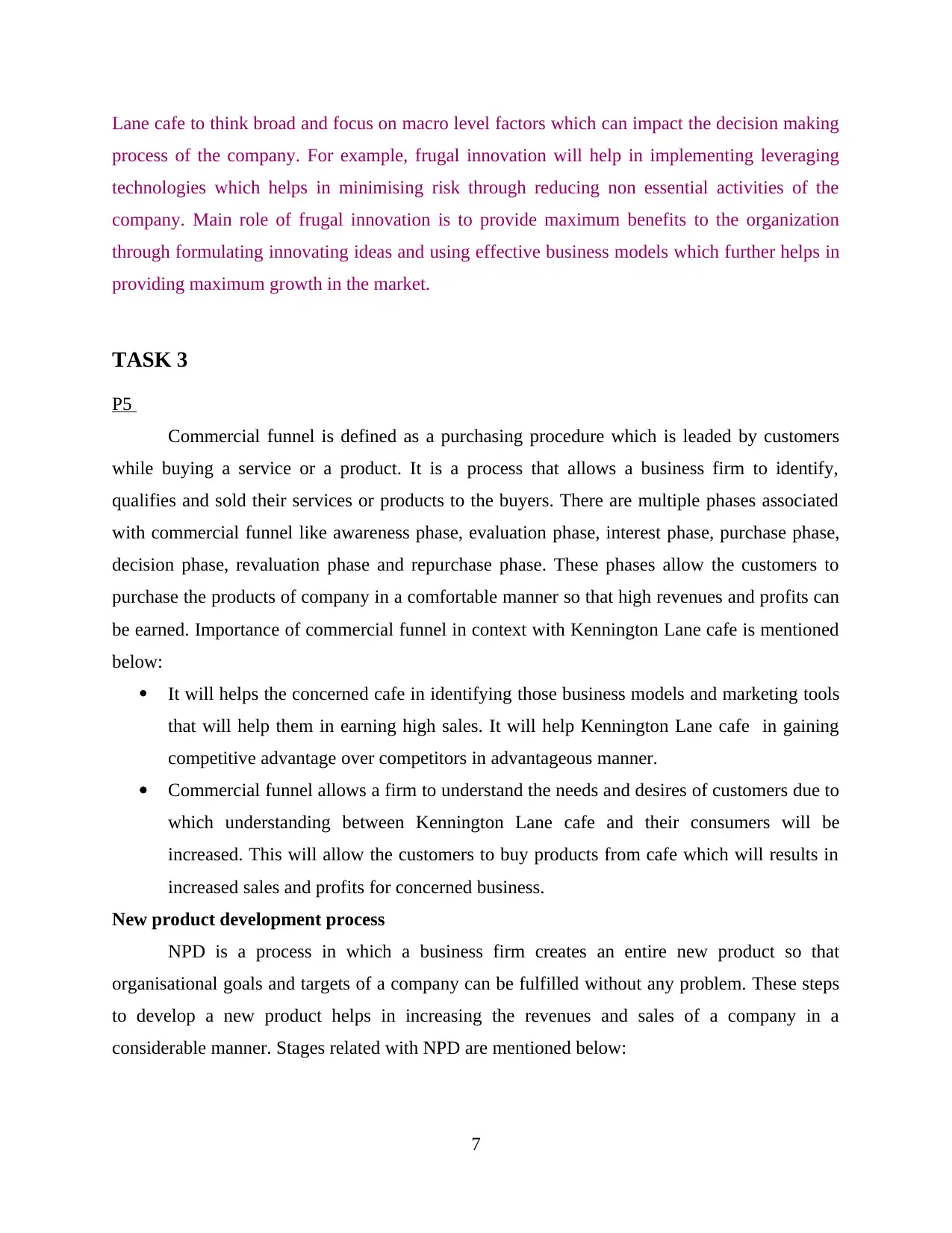
Lane cafe to think broad and focus on macro level factors which can impact the decision making
process of the company. For example, frugal innovation will help in implementing leveraging
technologies which helps in minimising risk through reducing non essential activities of the
company. Main role of frugal innovation is to provide maximum benefits to the organization
through formulating innovating ideas and using effective business models which further helps in
providing maximum growth in the market.
TASK 3
P5
Commercial funnel is defined as a purchasing procedure which is leaded by customers
while buying a service or a product. It is a process that allows a business firm to identify,
qualifies and sold their services or products to the buyers. There are multiple phases associated
with commercial funnel like awareness phase, evaluation phase, interest phase, purchase phase,
decision phase, revaluation phase and repurchase phase. These phases allow the customers to
purchase the products of company in a comfortable manner so that high revenues and profits can
be earned. Importance of commercial funnel in context with Kennington Lane cafe is mentioned
below:
It will helps the concerned cafe in identifying those business models and marketing tools
that will help them in earning high sales. It will help Kennington Lane cafe in gaining
competitive advantage over competitors in advantageous manner.
Commercial funnel allows a firm to understand the needs and desires of customers due to
which understanding between Kennington Lane cafe and their consumers will be
increased. This will allow the customers to buy products from cafe which will results in
increased sales and profits for concerned business.
New product development process
NPD is a process in which a business firm creates an entire new product so that
organisational goals and targets of a company can be fulfilled without any problem. These steps
to develop a new product helps in increasing the revenues and sales of a company in a
considerable manner. Stages related with NPD are mentioned below:
7
process of the company. For example, frugal innovation will help in implementing leveraging
technologies which helps in minimising risk through reducing non essential activities of the
company. Main role of frugal innovation is to provide maximum benefits to the organization
through formulating innovating ideas and using effective business models which further helps in
providing maximum growth in the market.
TASK 3
P5
Commercial funnel is defined as a purchasing procedure which is leaded by customers
while buying a service or a product. It is a process that allows a business firm to identify,
qualifies and sold their services or products to the buyers. There are multiple phases associated
with commercial funnel like awareness phase, evaluation phase, interest phase, purchase phase,
decision phase, revaluation phase and repurchase phase. These phases allow the customers to
purchase the products of company in a comfortable manner so that high revenues and profits can
be earned. Importance of commercial funnel in context with Kennington Lane cafe is mentioned
below:
It will helps the concerned cafe in identifying those business models and marketing tools
that will help them in earning high sales. It will help Kennington Lane cafe in gaining
competitive advantage over competitors in advantageous manner.
Commercial funnel allows a firm to understand the needs and desires of customers due to
which understanding between Kennington Lane cafe and their consumers will be
increased. This will allow the customers to buy products from cafe which will results in
increased sales and profits for concerned business.
New product development process
NPD is a process in which a business firm creates an entire new product so that
organisational goals and targets of a company can be fulfilled without any problem. These steps
to develop a new product helps in increasing the revenues and sales of a company in a
considerable manner. Stages related with NPD are mentioned below:
7
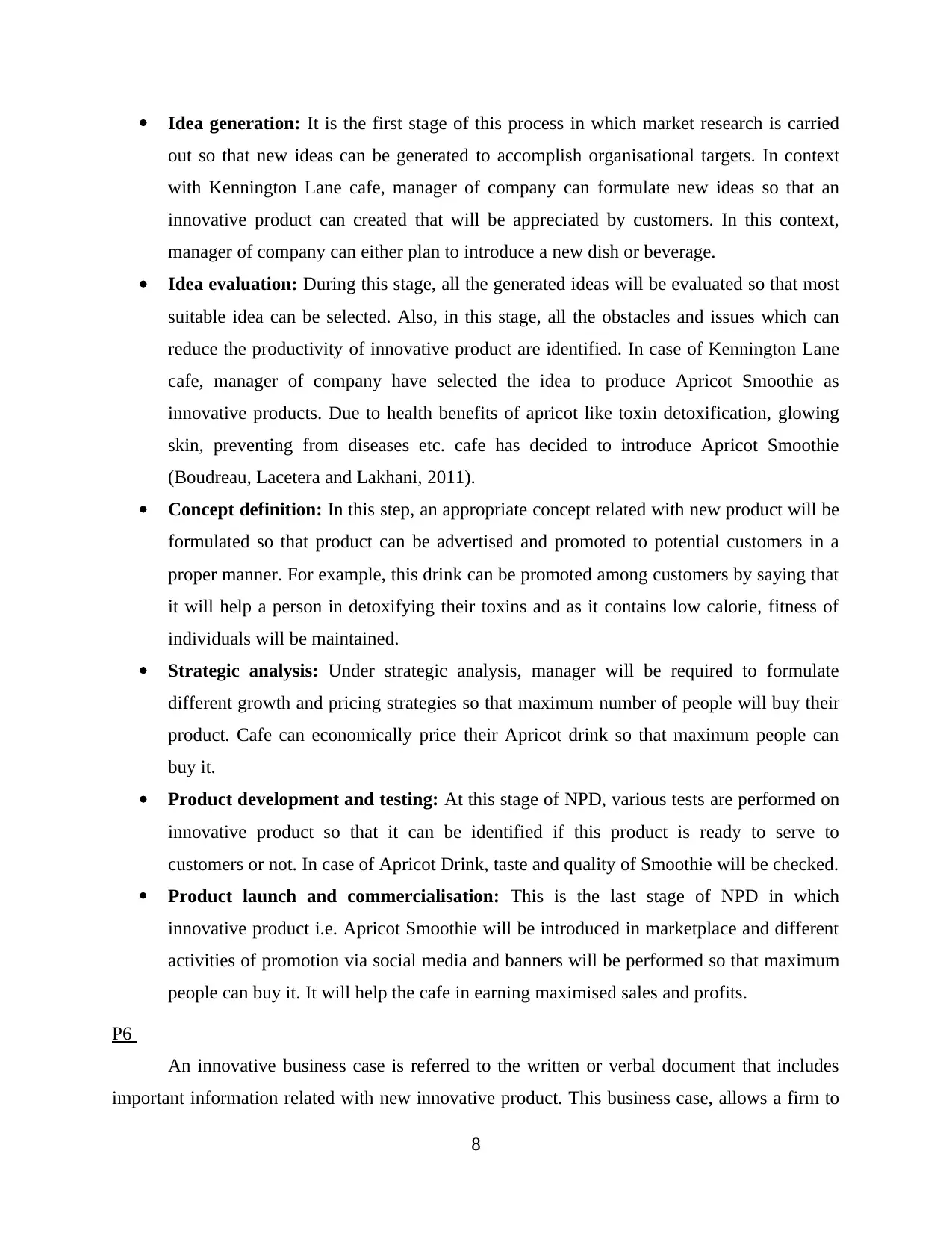
Idea generation: It is the first stage of this process in which market research is carried
out so that new ideas can be generated to accomplish organisational targets. In context
with Kennington Lane cafe, manager of company can formulate new ideas so that an
innovative product can created that will be appreciated by customers. In this context,
manager of company can either plan to introduce a new dish or beverage.
Idea evaluation: During this stage, all the generated ideas will be evaluated so that most
suitable idea can be selected. Also, in this stage, all the obstacles and issues which can
reduce the productivity of innovative product are identified. In case of Kennington Lane
cafe, manager of company have selected the idea to produce Apricot Smoothie as
innovative products. Due to health benefits of apricot like toxin detoxification, glowing
skin, preventing from diseases etc. cafe has decided to introduce Apricot Smoothie
(Boudreau, Lacetera and Lakhani, 2011).
Concept definition: In this step, an appropriate concept related with new product will be
formulated so that product can be advertised and promoted to potential customers in a
proper manner. For example, this drink can be promoted among customers by saying that
it will help a person in detoxifying their toxins and as it contains low calorie, fitness of
individuals will be maintained.
Strategic analysis: Under strategic analysis, manager will be required to formulate
different growth and pricing strategies so that maximum number of people will buy their
product. Cafe can economically price their Apricot drink so that maximum people can
buy it.
Product development and testing: At this stage of NPD, various tests are performed on
innovative product so that it can be identified if this product is ready to serve to
customers or not. In case of Apricot Drink, taste and quality of Smoothie will be checked.
Product launch and commercialisation: This is the last stage of NPD in which
innovative product i.e. Apricot Smoothie will be introduced in marketplace and different
activities of promotion via social media and banners will be performed so that maximum
people can buy it. It will help the cafe in earning maximised sales and profits.
P6
An innovative business case is referred to the written or verbal document that includes
important information related with new innovative product. This business case, allows a firm to
8
out so that new ideas can be generated to accomplish organisational targets. In context
with Kennington Lane cafe, manager of company can formulate new ideas so that an
innovative product can created that will be appreciated by customers. In this context,
manager of company can either plan to introduce a new dish or beverage.
Idea evaluation: During this stage, all the generated ideas will be evaluated so that most
suitable idea can be selected. Also, in this stage, all the obstacles and issues which can
reduce the productivity of innovative product are identified. In case of Kennington Lane
cafe, manager of company have selected the idea to produce Apricot Smoothie as
innovative products. Due to health benefits of apricot like toxin detoxification, glowing
skin, preventing from diseases etc. cafe has decided to introduce Apricot Smoothie
(Boudreau, Lacetera and Lakhani, 2011).
Concept definition: In this step, an appropriate concept related with new product will be
formulated so that product can be advertised and promoted to potential customers in a
proper manner. For example, this drink can be promoted among customers by saying that
it will help a person in detoxifying their toxins and as it contains low calorie, fitness of
individuals will be maintained.
Strategic analysis: Under strategic analysis, manager will be required to formulate
different growth and pricing strategies so that maximum number of people will buy their
product. Cafe can economically price their Apricot drink so that maximum people can
buy it.
Product development and testing: At this stage of NPD, various tests are performed on
innovative product so that it can be identified if this product is ready to serve to
customers or not. In case of Apricot Drink, taste and quality of Smoothie will be checked.
Product launch and commercialisation: This is the last stage of NPD in which
innovative product i.e. Apricot Smoothie will be introduced in marketplace and different
activities of promotion via social media and banners will be performed so that maximum
people can buy it. It will help the cafe in earning maximised sales and profits.
P6
An innovative business case is referred to the written or verbal document that includes
important information related with new innovative product. This business case, allows a firm to
8
Secure Best Marks with AI Grader
Need help grading? Try our AI Grader for instant feedback on your assignments.
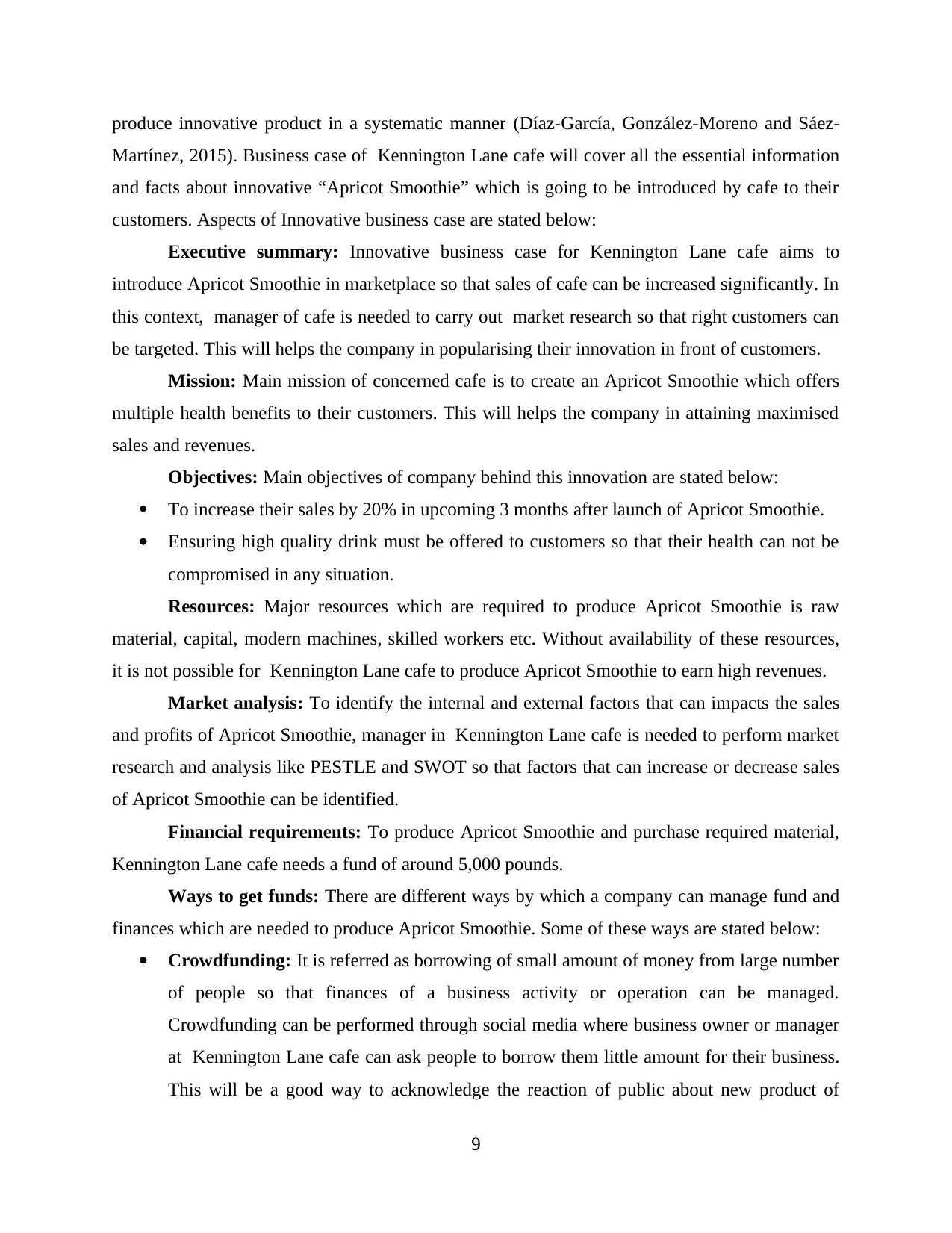
produce innovative product in a systematic manner (Díaz-García, González-Moreno and Sáez-
Martínez, 2015). Business case of Kennington Lane cafe will cover all the essential information
and facts about innovative “Apricot Smoothie” which is going to be introduced by cafe to their
customers. Aspects of Innovative business case are stated below:
Executive summary: Innovative business case for Kennington Lane cafe aims to
introduce Apricot Smoothie in marketplace so that sales of cafe can be increased significantly. In
this context, manager of cafe is needed to carry out market research so that right customers can
be targeted. This will helps the company in popularising their innovation in front of customers.
Mission: Main mission of concerned cafe is to create an Apricot Smoothie which offers
multiple health benefits to their customers. This will helps the company in attaining maximised
sales and revenues.
Objectives: Main objectives of company behind this innovation are stated below:
To increase their sales by 20% in upcoming 3 months after launch of Apricot Smoothie.
Ensuring high quality drink must be offered to customers so that their health can not be
compromised in any situation.
Resources: Major resources which are required to produce Apricot Smoothie is raw
material, capital, modern machines, skilled workers etc. Without availability of these resources,
it is not possible for Kennington Lane cafe to produce Apricot Smoothie to earn high revenues.
Market analysis: To identify the internal and external factors that can impacts the sales
and profits of Apricot Smoothie, manager in Kennington Lane cafe is needed to perform market
research and analysis like PESTLE and SWOT so that factors that can increase or decrease sales
of Apricot Smoothie can be identified.
Financial requirements: To produce Apricot Smoothie and purchase required material,
Kennington Lane cafe needs a fund of around 5,000 pounds.
Ways to get funds: There are different ways by which a company can manage fund and
finances which are needed to produce Apricot Smoothie. Some of these ways are stated below:
Crowdfunding: It is referred as borrowing of small amount of money from large number
of people so that finances of a business activity or operation can be managed.
Crowdfunding can be performed through social media where business owner or manager
at Kennington Lane cafe can ask people to borrow them little amount for their business.
This will be a good way to acknowledge the reaction of public about new product of
9
Martínez, 2015). Business case of Kennington Lane cafe will cover all the essential information
and facts about innovative “Apricot Smoothie” which is going to be introduced by cafe to their
customers. Aspects of Innovative business case are stated below:
Executive summary: Innovative business case for Kennington Lane cafe aims to
introduce Apricot Smoothie in marketplace so that sales of cafe can be increased significantly. In
this context, manager of cafe is needed to carry out market research so that right customers can
be targeted. This will helps the company in popularising their innovation in front of customers.
Mission: Main mission of concerned cafe is to create an Apricot Smoothie which offers
multiple health benefits to their customers. This will helps the company in attaining maximised
sales and revenues.
Objectives: Main objectives of company behind this innovation are stated below:
To increase their sales by 20% in upcoming 3 months after launch of Apricot Smoothie.
Ensuring high quality drink must be offered to customers so that their health can not be
compromised in any situation.
Resources: Major resources which are required to produce Apricot Smoothie is raw
material, capital, modern machines, skilled workers etc. Without availability of these resources,
it is not possible for Kennington Lane cafe to produce Apricot Smoothie to earn high revenues.
Market analysis: To identify the internal and external factors that can impacts the sales
and profits of Apricot Smoothie, manager in Kennington Lane cafe is needed to perform market
research and analysis like PESTLE and SWOT so that factors that can increase or decrease sales
of Apricot Smoothie can be identified.
Financial requirements: To produce Apricot Smoothie and purchase required material,
Kennington Lane cafe needs a fund of around 5,000 pounds.
Ways to get funds: There are different ways by which a company can manage fund and
finances which are needed to produce Apricot Smoothie. Some of these ways are stated below:
Crowdfunding: It is referred as borrowing of small amount of money from large number
of people so that finances of a business activity or operation can be managed.
Crowdfunding can be performed through social media where business owner or manager
at Kennington Lane cafe can ask people to borrow them little amount for their business.
This will be a good way to acknowledge the reaction of public about new product of
9
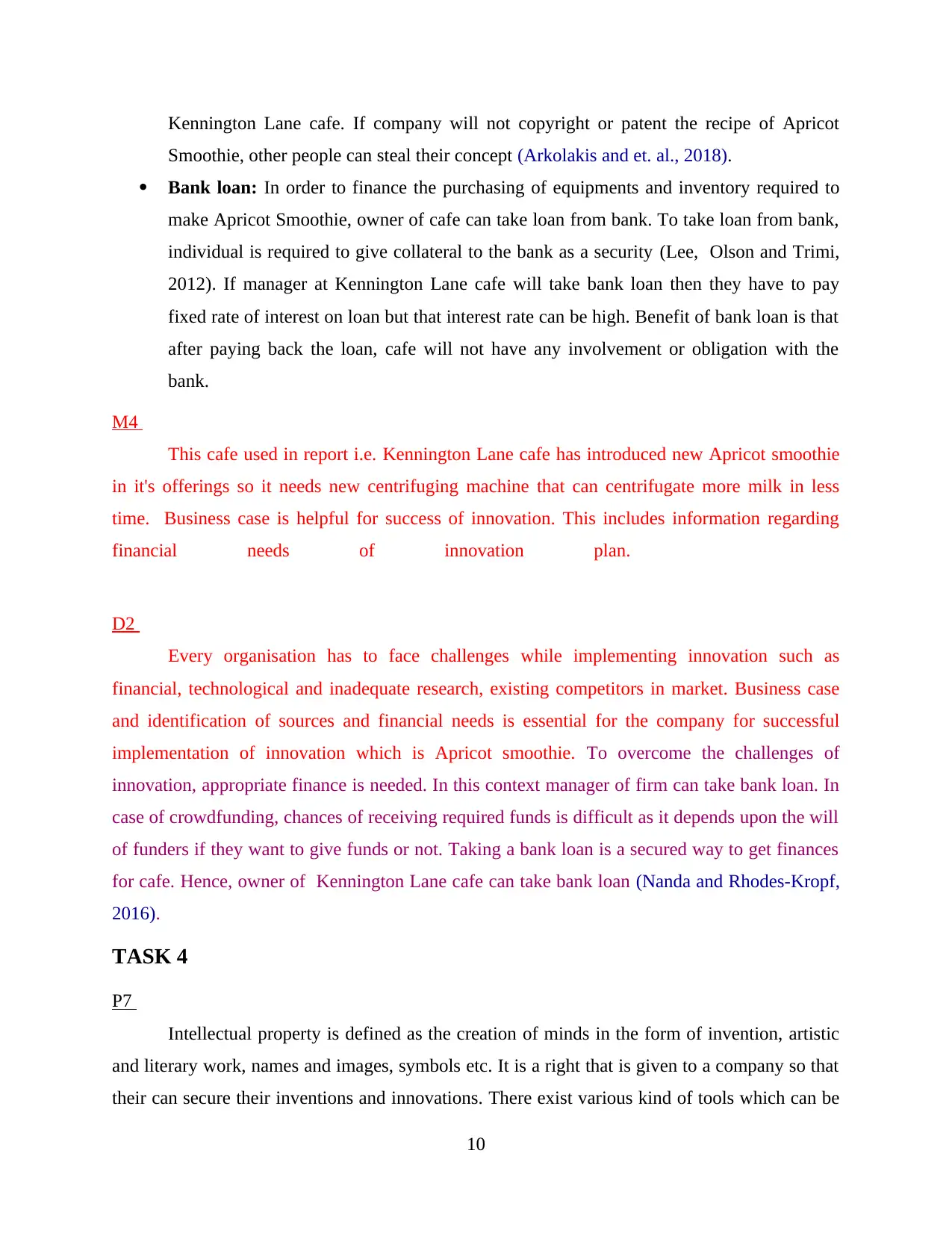
Kennington Lane cafe. If company will not copyright or patent the recipe of Apricot
Smoothie, other people can steal their concept (Arkolakis and et. al., 2018).
Bank loan: In order to finance the purchasing of equipments and inventory required to
make Apricot Smoothie, owner of cafe can take loan from bank. To take loan from bank,
individual is required to give collateral to the bank as a security (Lee, Olson and Trimi,
2012). If manager at Kennington Lane cafe will take bank loan then they have to pay
fixed rate of interest on loan but that interest rate can be high. Benefit of bank loan is that
after paying back the loan, cafe will not have any involvement or obligation with the
bank.
M4
This cafe used in report i.e. Kennington Lane cafe has introduced new Apricot smoothie
in it's offerings so it needs new centrifuging machine that can centrifugate more milk in less
time. Business case is helpful for success of innovation. This includes information regarding
financial needs of innovation plan.
D2
Every organisation has to face challenges while implementing innovation such as
financial, technological and inadequate research, existing competitors in market. Business case
and identification of sources and financial needs is essential for the company for successful
implementation of innovation which is Apricot smoothie. To overcome the challenges of
innovation, appropriate finance is needed. In this context manager of firm can take bank loan. In
case of crowdfunding, chances of receiving required funds is difficult as it depends upon the will
of funders if they want to give funds or not. Taking a bank loan is a secured way to get finances
for cafe. Hence, owner of Kennington Lane cafe can take bank loan (Nanda and Rhodes-Kropf,
2016).
TASK 4
P7
Intellectual property is defined as the creation of minds in the form of invention, artistic
and literary work, names and images, symbols etc. It is a right that is given to a company so that
their can secure their inventions and innovations. There exist various kind of tools which can be
10
Smoothie, other people can steal their concept (Arkolakis and et. al., 2018).
Bank loan: In order to finance the purchasing of equipments and inventory required to
make Apricot Smoothie, owner of cafe can take loan from bank. To take loan from bank,
individual is required to give collateral to the bank as a security (Lee, Olson and Trimi,
2012). If manager at Kennington Lane cafe will take bank loan then they have to pay
fixed rate of interest on loan but that interest rate can be high. Benefit of bank loan is that
after paying back the loan, cafe will not have any involvement or obligation with the
bank.
M4
This cafe used in report i.e. Kennington Lane cafe has introduced new Apricot smoothie
in it's offerings so it needs new centrifuging machine that can centrifugate more milk in less
time. Business case is helpful for success of innovation. This includes information regarding
financial needs of innovation plan.
D2
Every organisation has to face challenges while implementing innovation such as
financial, technological and inadequate research, existing competitors in market. Business case
and identification of sources and financial needs is essential for the company for successful
implementation of innovation which is Apricot smoothie. To overcome the challenges of
innovation, appropriate finance is needed. In this context manager of firm can take bank loan. In
case of crowdfunding, chances of receiving required funds is difficult as it depends upon the will
of funders if they want to give funds or not. Taking a bank loan is a secured way to get finances
for cafe. Hence, owner of Kennington Lane cafe can take bank loan (Nanda and Rhodes-Kropf,
2016).
TASK 4
P7
Intellectual property is defined as the creation of minds in the form of invention, artistic
and literary work, names and images, symbols etc. It is a right that is given to a company so that
their can secure their inventions and innovations. There exist various kind of tools which can be
10
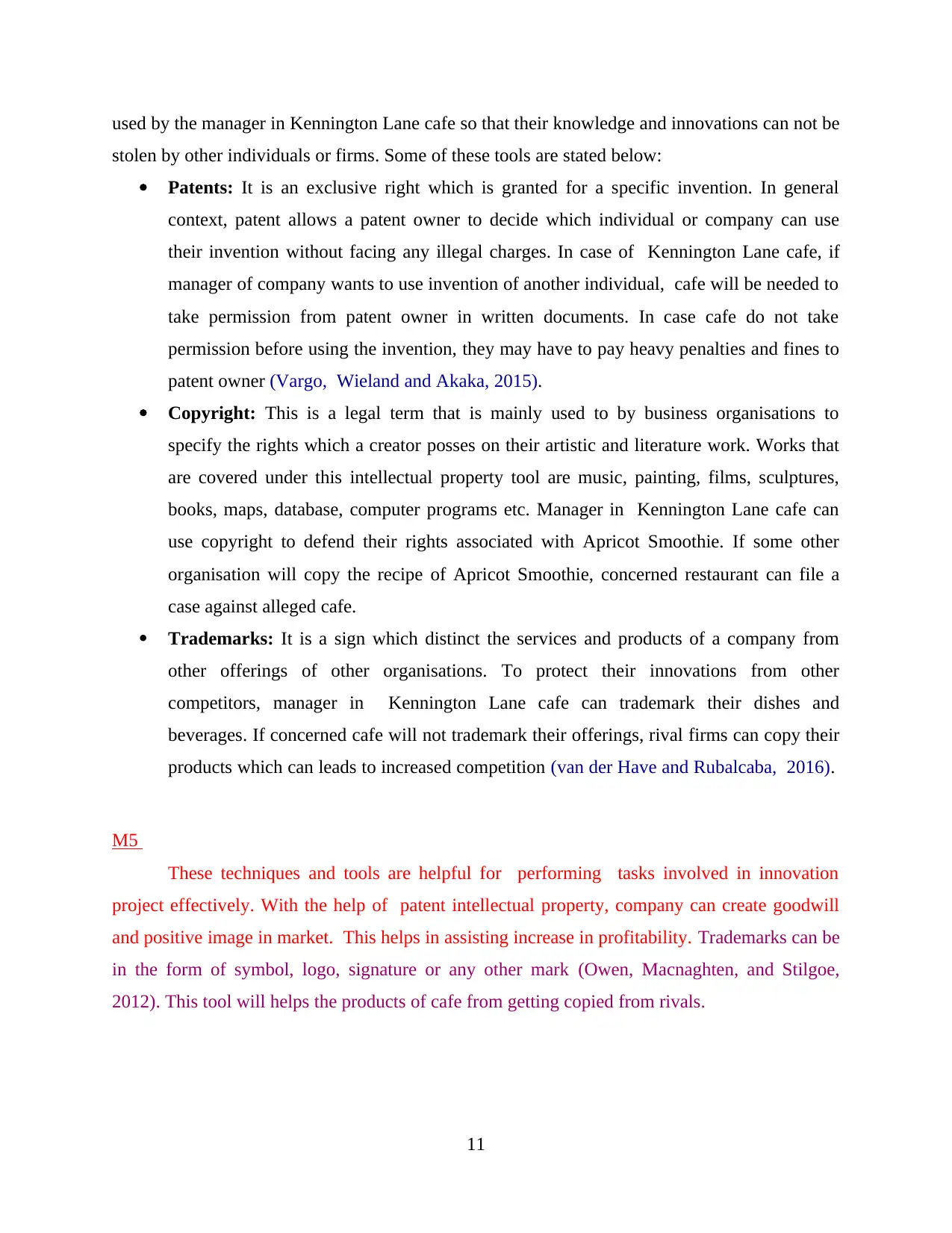
used by the manager in Kennington Lane cafe so that their knowledge and innovations can not be
stolen by other individuals or firms. Some of these tools are stated below:
Patents: It is an exclusive right which is granted for a specific invention. In general
context, patent allows a patent owner to decide which individual or company can use
their invention without facing any illegal charges. In case of Kennington Lane cafe, if
manager of company wants to use invention of another individual, cafe will be needed to
take permission from patent owner in written documents. In case cafe do not take
permission before using the invention, they may have to pay heavy penalties and fines to
patent owner (Vargo, Wieland and Akaka, 2015).
Copyright: This is a legal term that is mainly used to by business organisations to
specify the rights which a creator posses on their artistic and literature work. Works that
are covered under this intellectual property tool are music, painting, films, sculptures,
books, maps, database, computer programs etc. Manager in Kennington Lane cafe can
use copyright to defend their rights associated with Apricot Smoothie. If some other
organisation will copy the recipe of Apricot Smoothie, concerned restaurant can file a
case against alleged cafe.
Trademarks: It is a sign which distinct the services and products of a company from
other offerings of other organisations. To protect their innovations from other
competitors, manager in Kennington Lane cafe can trademark their dishes and
beverages. If concerned cafe will not trademark their offerings, rival firms can copy their
products which can leads to increased competition (van der Have and Rubalcaba, 2016).
M5
These techniques and tools are helpful for performing tasks involved in innovation
project effectively. With the help of patent intellectual property, company can create goodwill
and positive image in market. This helps in assisting increase in profitability. Trademarks can be
in the form of symbol, logo, signature or any other mark (Owen, Macnaghten, and Stilgoe,
2012). This tool will helps the products of cafe from getting copied from rivals.
11
stolen by other individuals or firms. Some of these tools are stated below:
Patents: It is an exclusive right which is granted for a specific invention. In general
context, patent allows a patent owner to decide which individual or company can use
their invention without facing any illegal charges. In case of Kennington Lane cafe, if
manager of company wants to use invention of another individual, cafe will be needed to
take permission from patent owner in written documents. In case cafe do not take
permission before using the invention, they may have to pay heavy penalties and fines to
patent owner (Vargo, Wieland and Akaka, 2015).
Copyright: This is a legal term that is mainly used to by business organisations to
specify the rights which a creator posses on their artistic and literature work. Works that
are covered under this intellectual property tool are music, painting, films, sculptures,
books, maps, database, computer programs etc. Manager in Kennington Lane cafe can
use copyright to defend their rights associated with Apricot Smoothie. If some other
organisation will copy the recipe of Apricot Smoothie, concerned restaurant can file a
case against alleged cafe.
Trademarks: It is a sign which distinct the services and products of a company from
other offerings of other organisations. To protect their innovations from other
competitors, manager in Kennington Lane cafe can trademark their dishes and
beverages. If concerned cafe will not trademark their offerings, rival firms can copy their
products which can leads to increased competition (van der Have and Rubalcaba, 2016).
M5
These techniques and tools are helpful for performing tasks involved in innovation
project effectively. With the help of patent intellectual property, company can create goodwill
and positive image in market. This helps in assisting increase in profitability. Trademarks can be
in the form of symbol, logo, signature or any other mark (Owen, Macnaghten, and Stilgoe,
2012). This tool will helps the products of cafe from getting copied from rivals.
11
Paraphrase This Document
Need a fresh take? Get an instant paraphrase of this document with our AI Paraphraser
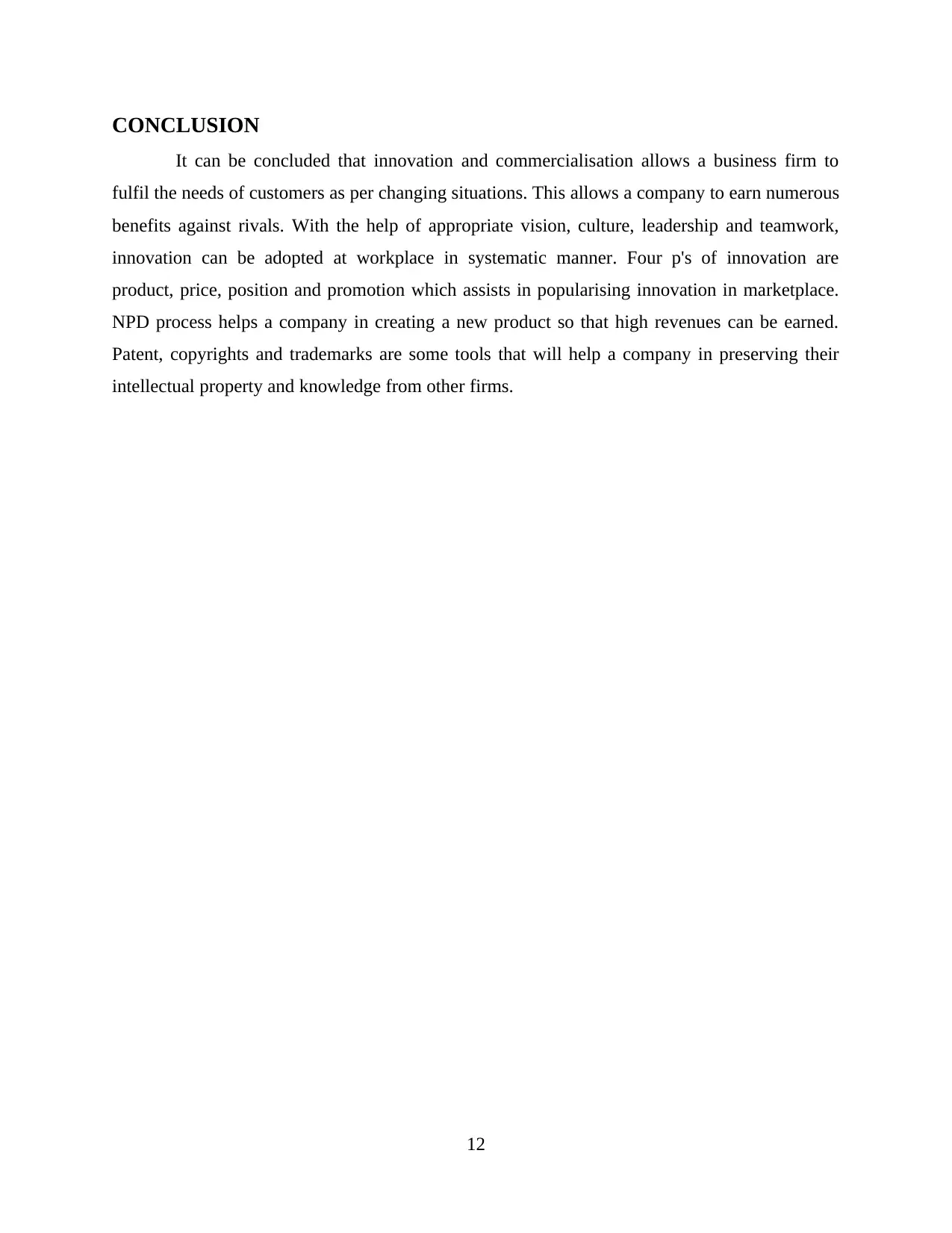
CONCLUSION
It can be concluded that innovation and commercialisation allows a business firm to
fulfil the needs of customers as per changing situations. This allows a company to earn numerous
benefits against rivals. With the help of appropriate vision, culture, leadership and teamwork,
innovation can be adopted at workplace in systematic manner. Four p's of innovation are
product, price, position and promotion which assists in popularising innovation in marketplace.
NPD process helps a company in creating a new product so that high revenues can be earned.
Patent, copyrights and trademarks are some tools that will help a company in preserving their
intellectual property and knowledge from other firms.
12
It can be concluded that innovation and commercialisation allows a business firm to
fulfil the needs of customers as per changing situations. This allows a company to earn numerous
benefits against rivals. With the help of appropriate vision, culture, leadership and teamwork,
innovation can be adopted at workplace in systematic manner. Four p's of innovation are
product, price, position and promotion which assists in popularising innovation in marketplace.
NPD process helps a company in creating a new product so that high revenues can be earned.
Patent, copyrights and trademarks are some tools that will help a company in preserving their
intellectual property and knowledge from other firms.
12
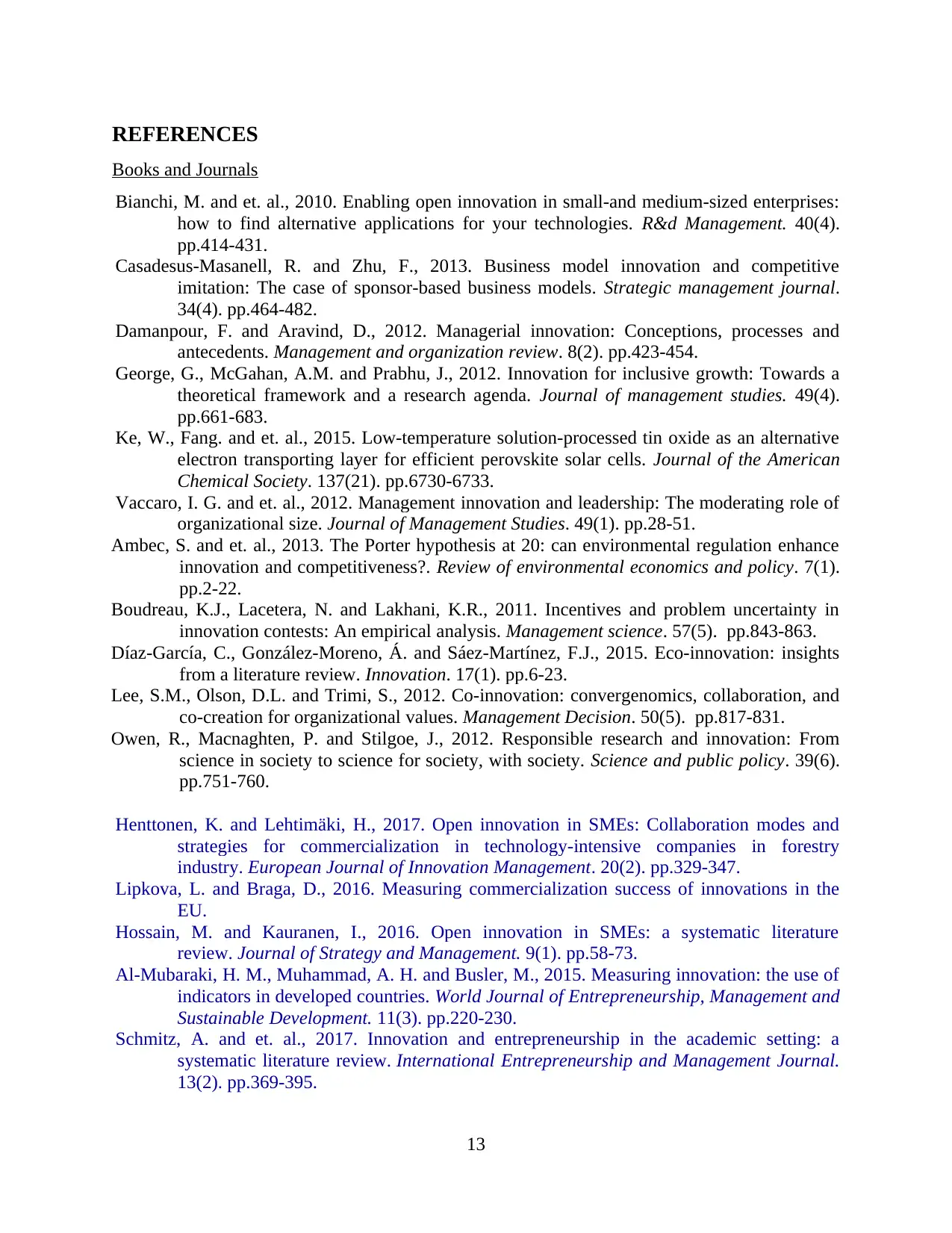
REFERENCES
Books and Journals
Bianchi, M. and et. al., 2010. Enabling open innovation in small‐and medium‐sized enterprises:
how to find alternative applications for your technologies. R&d Management. 40(4).
pp.414-431.
Casadesus‐Masanell, R. and Zhu, F., 2013. Business model innovation and competitive
imitation: The case of sponsor‐based business models. Strategic management journal.
34(4). pp.464-482.
Damanpour, F. and Aravind, D., 2012. Managerial innovation: Conceptions, processes and
antecedents. Management and organization review. 8(2). pp.423-454.
George, G., McGahan, A.M. and Prabhu, J., 2012. Innovation for inclusive growth: Towards a
theoretical framework and a research agenda. Journal of management studies. 49(4).
pp.661-683.
Ke, W., Fang. and et. al., 2015. Low-temperature solution-processed tin oxide as an alternative
electron transporting layer for efficient perovskite solar cells. Journal of the American
Chemical Society. 137(21). pp.6730-6733.
Vaccaro, I. G. and et. al., 2012. Management innovation and leadership: The moderating role of
organizational size. Journal of Management Studies. 49(1). pp.28-51.
Ambec, S. and et. al., 2013. The Porter hypothesis at 20: can environmental regulation enhance
innovation and competitiveness?. Review of environmental economics and policy. 7(1).
pp.2-22.
Boudreau, K.J., Lacetera, N. and Lakhani, K.R., 2011. Incentives and problem uncertainty in
innovation contests: An empirical analysis. Management science. 57(5). pp.843-863.
Díaz-García, C., González-Moreno, Á. and Sáez-Martínez, F.J., 2015. Eco-innovation: insights
from a literature review. Innovation. 17(1). pp.6-23.
Lee, S.M., Olson, D.L. and Trimi, S., 2012. Co-innovation: convergenomics, collaboration, and
co-creation for organizational values. Management Decision. 50(5). pp.817-831.
Owen, R., Macnaghten, P. and Stilgoe, J., 2012. Responsible research and innovation: From
science in society to science for society, with society. Science and public policy. 39(6).
pp.751-760.
Henttonen, K. and Lehtimäki, H., 2017. Open innovation in SMEs: Collaboration modes and
strategies for commercialization in technology-intensive companies in forestry
industry. European Journal of Innovation Management. 20(2). pp.329-347.
Lipkova, L. and Braga, D., 2016. Measuring commercialization success of innovations in the
EU.
Hossain, M. and Kauranen, I., 2016. Open innovation in SMEs: a systematic literature
review. Journal of Strategy and Management. 9(1). pp.58-73.
Al-Mubaraki, H. M., Muhammad, A. H. and Busler, M., 2015. Measuring innovation: the use of
indicators in developed countries. World Journal of Entrepreneurship, Management and
Sustainable Development. 11(3). pp.220-230.
Schmitz, A. and et. al., 2017. Innovation and entrepreneurship in the academic setting: a
systematic literature review. International Entrepreneurship and Management Journal.
13(2). pp.369-395.
13
Books and Journals
Bianchi, M. and et. al., 2010. Enabling open innovation in small‐and medium‐sized enterprises:
how to find alternative applications for your technologies. R&d Management. 40(4).
pp.414-431.
Casadesus‐Masanell, R. and Zhu, F., 2013. Business model innovation and competitive
imitation: The case of sponsor‐based business models. Strategic management journal.
34(4). pp.464-482.
Damanpour, F. and Aravind, D., 2012. Managerial innovation: Conceptions, processes and
antecedents. Management and organization review. 8(2). pp.423-454.
George, G., McGahan, A.M. and Prabhu, J., 2012. Innovation for inclusive growth: Towards a
theoretical framework and a research agenda. Journal of management studies. 49(4).
pp.661-683.
Ke, W., Fang. and et. al., 2015. Low-temperature solution-processed tin oxide as an alternative
electron transporting layer for efficient perovskite solar cells. Journal of the American
Chemical Society. 137(21). pp.6730-6733.
Vaccaro, I. G. and et. al., 2012. Management innovation and leadership: The moderating role of
organizational size. Journal of Management Studies. 49(1). pp.28-51.
Ambec, S. and et. al., 2013. The Porter hypothesis at 20: can environmental regulation enhance
innovation and competitiveness?. Review of environmental economics and policy. 7(1).
pp.2-22.
Boudreau, K.J., Lacetera, N. and Lakhani, K.R., 2011. Incentives and problem uncertainty in
innovation contests: An empirical analysis. Management science. 57(5). pp.843-863.
Díaz-García, C., González-Moreno, Á. and Sáez-Martínez, F.J., 2015. Eco-innovation: insights
from a literature review. Innovation. 17(1). pp.6-23.
Lee, S.M., Olson, D.L. and Trimi, S., 2012. Co-innovation: convergenomics, collaboration, and
co-creation for organizational values. Management Decision. 50(5). pp.817-831.
Owen, R., Macnaghten, P. and Stilgoe, J., 2012. Responsible research and innovation: From
science in society to science for society, with society. Science and public policy. 39(6).
pp.751-760.
Henttonen, K. and Lehtimäki, H., 2017. Open innovation in SMEs: Collaboration modes and
strategies for commercialization in technology-intensive companies in forestry
industry. European Journal of Innovation Management. 20(2). pp.329-347.
Lipkova, L. and Braga, D., 2016. Measuring commercialization success of innovations in the
EU.
Hossain, M. and Kauranen, I., 2016. Open innovation in SMEs: a systematic literature
review. Journal of Strategy and Management. 9(1). pp.58-73.
Al-Mubaraki, H. M., Muhammad, A. H. and Busler, M., 2015. Measuring innovation: the use of
indicators in developed countries. World Journal of Entrepreneurship, Management and
Sustainable Development. 11(3). pp.220-230.
Schmitz, A. and et. al., 2017. Innovation and entrepreneurship in the academic setting: a
systematic literature review. International Entrepreneurship and Management Journal.
13(2). pp.369-395.
13
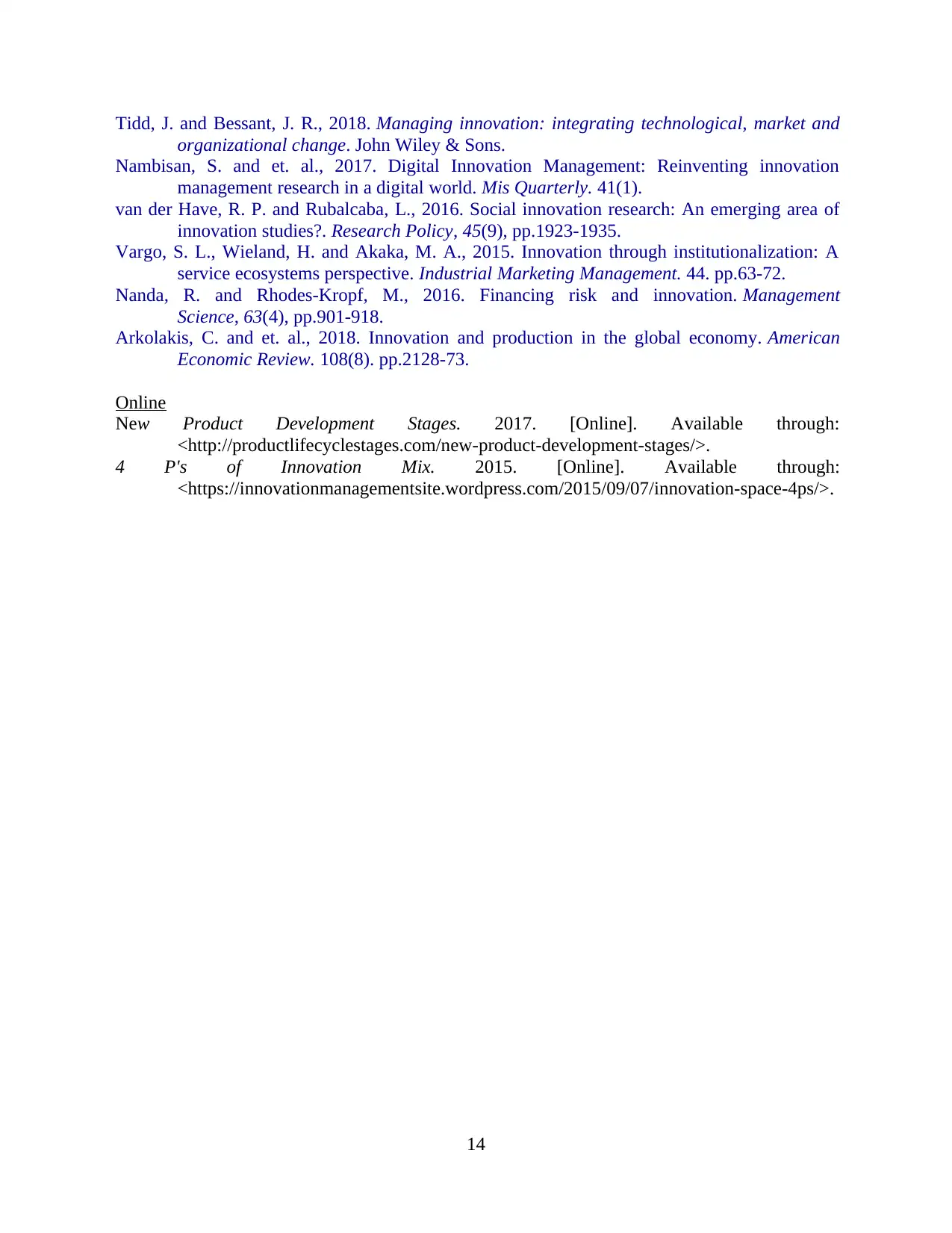
Tidd, J. and Bessant, J. R., 2018. Managing innovation: integrating technological, market and
organizational change. John Wiley & Sons.
Nambisan, S. and et. al., 2017. Digital Innovation Management: Reinventing innovation
management research in a digital world. Mis Quarterly. 41(1).
van der Have, R. P. and Rubalcaba, L., 2016. Social innovation research: An emerging area of
innovation studies?. Research Policy, 45(9), pp.1923-1935.
Vargo, S. L., Wieland, H. and Akaka, M. A., 2015. Innovation through institutionalization: A
service ecosystems perspective. Industrial Marketing Management. 44. pp.63-72.
Nanda, R. and Rhodes-Kropf, M., 2016. Financing risk and innovation. Management
Science, 63(4), pp.901-918.
Arkolakis, C. and et. al., 2018. Innovation and production in the global economy. American
Economic Review. 108(8). pp.2128-73.
Online
New Product Development Stages. 2017. [Online]. Available through:
<http://productlifecyclestages.com/new-product-development-stages/>.
4 P's of Innovation Mix. 2015. [Online]. Available through:
<https://innovationmanagementsite.wordpress.com/2015/09/07/innovation-space-4ps/>.
14
organizational change. John Wiley & Sons.
Nambisan, S. and et. al., 2017. Digital Innovation Management: Reinventing innovation
management research in a digital world. Mis Quarterly. 41(1).
van der Have, R. P. and Rubalcaba, L., 2016. Social innovation research: An emerging area of
innovation studies?. Research Policy, 45(9), pp.1923-1935.
Vargo, S. L., Wieland, H. and Akaka, M. A., 2015. Innovation through institutionalization: A
service ecosystems perspective. Industrial Marketing Management. 44. pp.63-72.
Nanda, R. and Rhodes-Kropf, M., 2016. Financing risk and innovation. Management
Science, 63(4), pp.901-918.
Arkolakis, C. and et. al., 2018. Innovation and production in the global economy. American
Economic Review. 108(8). pp.2128-73.
Online
New Product Development Stages. 2017. [Online]. Available through:
<http://productlifecyclestages.com/new-product-development-stages/>.
4 P's of Innovation Mix. 2015. [Online]. Available through:
<https://innovationmanagementsite.wordpress.com/2015/09/07/innovation-space-4ps/>.
14
1 out of 16
Related Documents
Your All-in-One AI-Powered Toolkit for Academic Success.
+13062052269
info@desklib.com
Available 24*7 on WhatsApp / Email
![[object Object]](/_next/static/media/star-bottom.7253800d.svg)
Unlock your academic potential
© 2024 | Zucol Services PVT LTD | All rights reserved.





